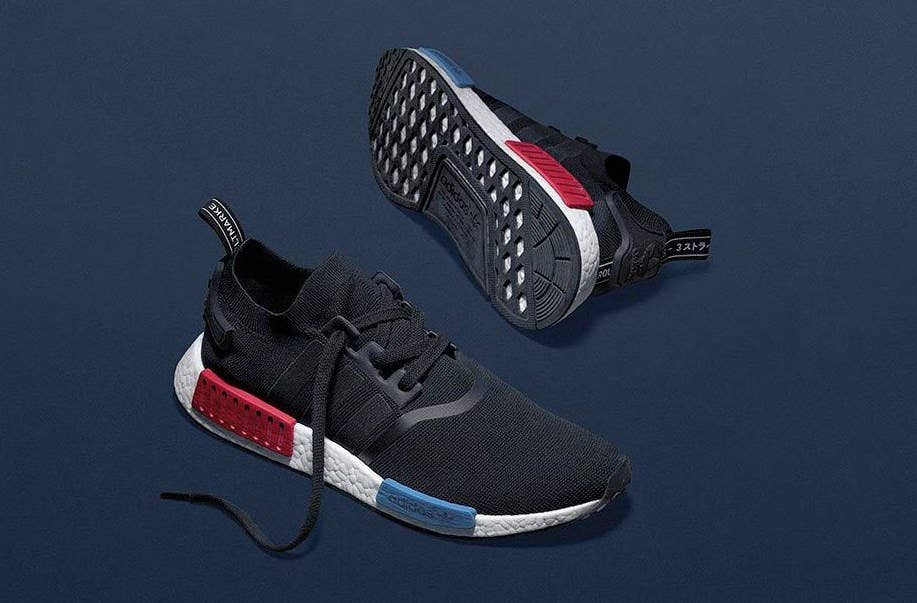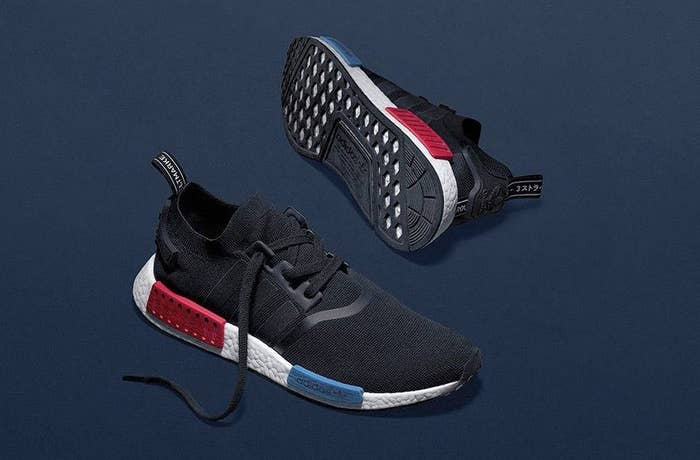
Today, if you had to guess which sneaker caused stampedes in Taiwan, overnight camping in the UK, and complete chaos in Thailand, the Adidas NMD would probably not be the first one to come to mind—but by 2016, the sneaker had done all that and more. Sneaker collectors with a short memory may have forgotten, but there was a time when the NMD reigned supreme.
In 2015, Adidas Originals was the hottest brand on Instagram, and the data backs it up. According to research by British-based graphic designer Dan Freebairn, Adidas Originals garnered over 78 million likes on Instagram that year, nearly equal to Nike and its Jordan Brand and Converse subsidiaries combined.

While the NMD took sneaker culture by storm, the momentum around Adidas had been building for months prior. There were several moments and strategic moves that helped usher in the era of the NMD.
The first key moment happened in 2014 when Adidas poached three designers from Nike: Marc Dolce, Denis Dekovic, and Mark Miner. Nike later went on to sue the designers for $10 million, claiming they had stolen trade secrets and broken their non-compete agreements. Shortly after joining Adidas, the trio would help open up a design studio in Brooklyn.
Another pivotal moment was Adidas’ now-terminated partnership with Kanye West who, at the time, was fresh off severing ties with Nike and looking to evolve his fashion empire. For Adidas, the move marked an intentional decision to grow brand presence in the U.S. market and further merge lifestyle and sportswear design. During 2015 NBA All-Star Weekend in February, the collaboration debuted via West’s first Adidas sneaker, the Yeezy Boost 750.
Ye’s cultural ascension, coupled with the sneaker’s unique design, helped the Yeezy Boost 750 become one of the most hyped Adidas products, and would provide a spark for the brand’s next standout sneaker in the Ultra Boost.
The original black and purple Ultra Boost dropped on Feb. 11, three days before the Yeezy Boost 750, but it wasn’t until that summer that the shoe became a hit with audiences outside of performance enthusiasts. That May, West, who had also frequently donned the original Ultra Boost colorway, again displayed his ability to propel the brand forward. Multiple times that summer he was photographed wearing the Ultra Boost “Triple White,” which generated extreme hype for the sneaker.
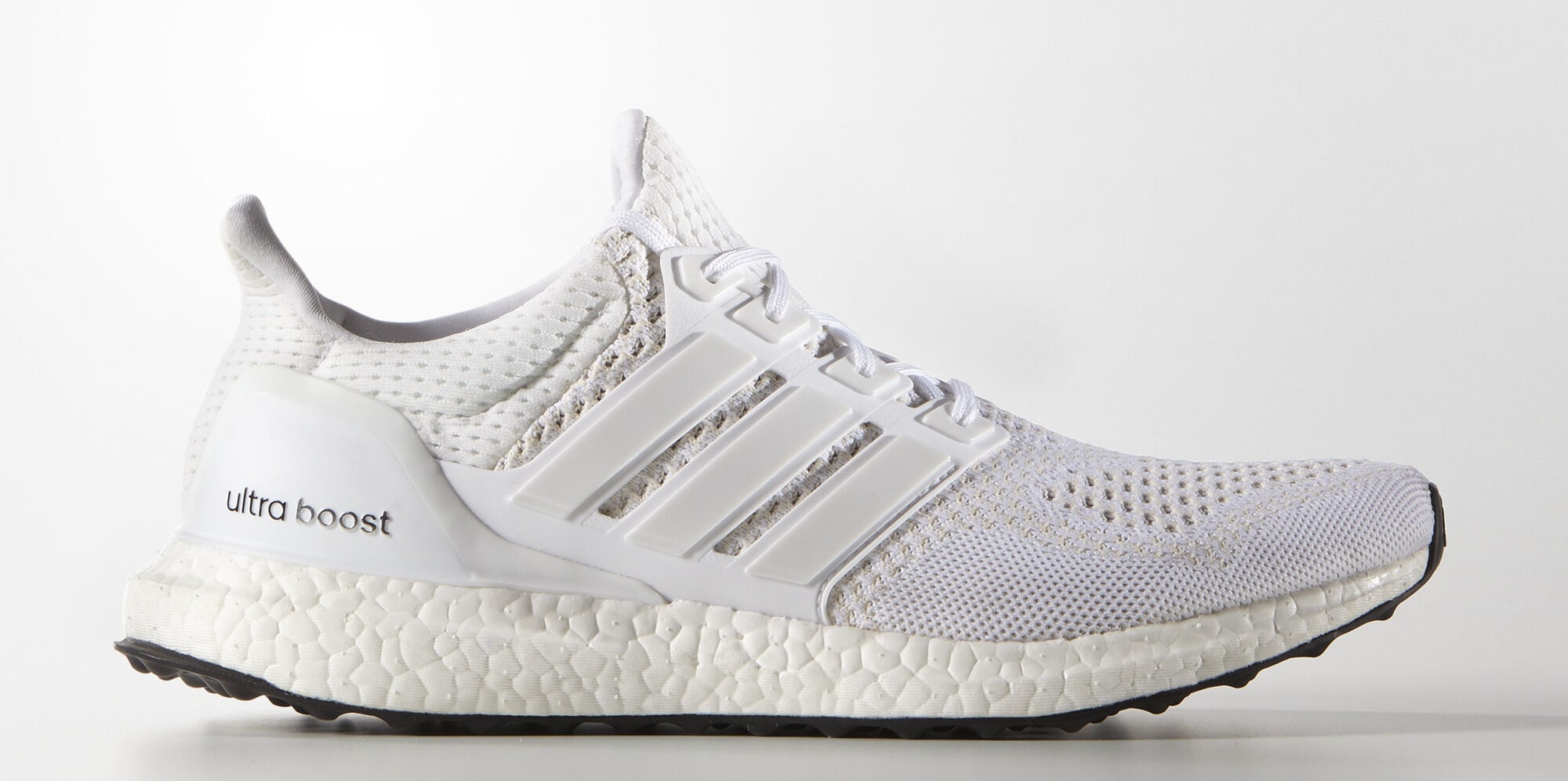
Harrison Davis, a private client senior manager at Stadium Goods, adds, “When West performed at the Billboard Music Awards in the ‘Triple White’ Ultra Boost, he created a streetwear fervor for [Boost] technology and reinvigoration for collecting Adidas.”
At that time, Nike and Jordan Brand dominated the aftermarket, but the early days of the Ultra Boost and Yeezy sneakers helped open up the door for more competition.
“After Kanye released his first Yeezy 350s into the market, sneaker collectors zeroed in on buying Adidas and it set the stage for Adidas to infuse more accessible pairs utilizing Boost technology into the market,” Davis says.
According to data from StockX founder and former CEO Josh Luber’s early website Campless, Adidas’ aftermarket presence in 2014 accounted for less than 1 percent, but by 2015, grew to roughly 20 percent due in large part to the Ultra Boost and Yeezy sneakers.
The following year, when StockX was officially launched, Adidas accounted for roughly half of their marketplace and many of the sneakers sold for around 50 percent over retail value.
By 2018, the supply would catch up to the demand and slow the Ultra Boost’s momentum, foreshadowing a similar fate awaiting the brand’s next big sneaker.
On Dec. 9, 2015, Adidas Originals held an event in New York to showcase the NMD (short for Nomad) to press and retailers, with celebrities like A$AP Ferg, G-Eazy, and Theophilus London in attendance. Till Jagla, former head of footwear concepts and energy at Adidas Originals, believes the event was a success due to the seeding strategy used for the shoe.
“I still remember how many people from the event took their seeding pairs into the streets of NYC and created dope content,” Jagla says. “The shoe manifested within the urban environment right from the get-go. All key markets started to seed the products to their pinnacle consumers who were known for their urban lifestyle.”
Two days later, the shoe launched to the general public for $170. It featured a Primeknit sock-like upper, a Boost sole, and referenced ‘80s design elements from the Micro Pacer, Rising Star, and Boston Supermodels. The brand successfully balanced the adoption of archival sneaker characteristics while also weaving in a more modern silhouette.
This tightrope is no easy one to walk but in an interview with GQ, Nic Galway, vice president of global design for Adidas Originals, said the NMD was the brand’s way of “connecting the past and the future in the most comfortable way.” The new approach, tech-wise, helped elevate the status of the brand in a market that craved more versatility.
Where the focus for the Ultra Boost was to build “the best running shoe in the world,” the NMD Adidas shifted to building a lifestyle sneaker that could be worn in a variety of scenarios. The NMD R1 “OG,” became an instant hit and, at its height, was reselling for $1,000, five times more than the retail value.
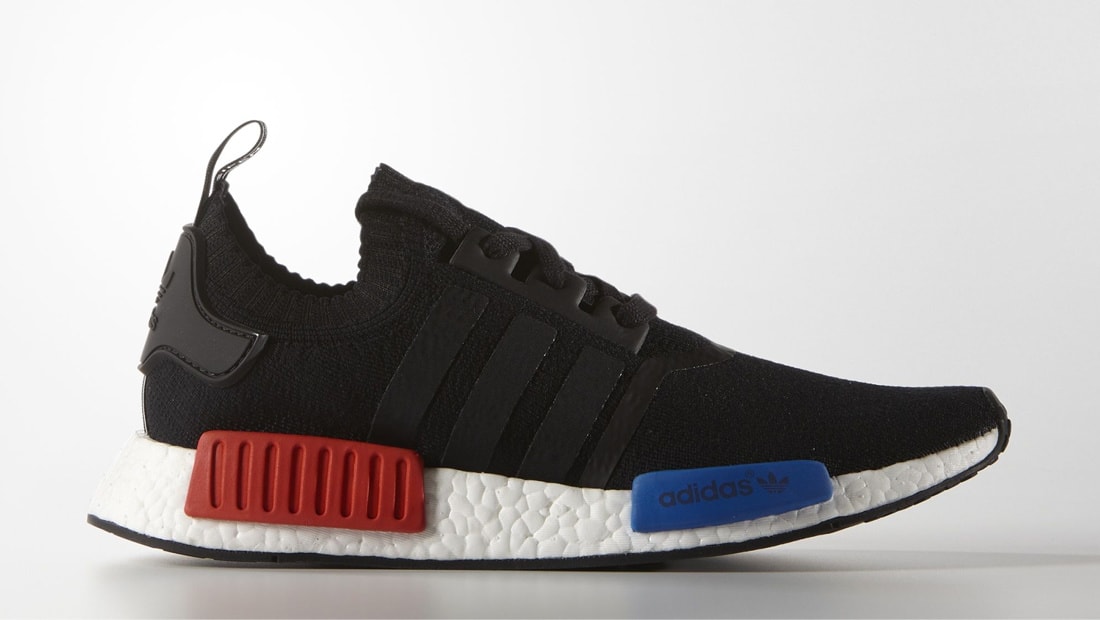
Despite all the moves from Adidas, Nike was far from silent in 2015 and released a number of coveted sneakers. The top standouts from the Swoosh umbrella were the Air Jordan 1 “Chicago,” the HTM x Kobe X Elite Low, Air Jordan 4 “Oreo,” Flyknit Racer ‘Multicolor 2.0,’ and the Nike Sock Darts.
On the other hand, Adidas followed up the strong momentum with an even better performance in 2016, led by multiple NMD colorways and collaborations. A quick search on StockX will result in around 162 NMD colorways from January to December 2016. Despite many of them falling within the general release category, they all quickly sold out, causing a global frenzy in the process. Around the world, stores like Foot Locker saw fans lining up for hours, just for a chance to cop a general NMD colorway.
For the most part, lines were kept under control, but many moments globally saw shops canceling drops due to overzealous sneakerheads or too dangerous of shopping environments—one of the worst happening in Taiwan. Impatient customers stormed the mall in an attempt to grab stock NMDs and in the frenzy trampled over those who’d fallen during the stampede.
Situations like these eventually contributed to the adoption of raffle and ticketing models to protect both store employees and consumers.
On the more hype end of the spectrum, some of the most notable makeups included the “Primeknit White,” “Pitch Black Friends and Family,” White Mountaineering x NMD City Sock, A Bathing Ape x NMD, and the Nice Kicks x NMD. One of these pairs that especially stood out to Jagla was the “Pitch Black Friends and Family” edition, the rarest pair released that year.
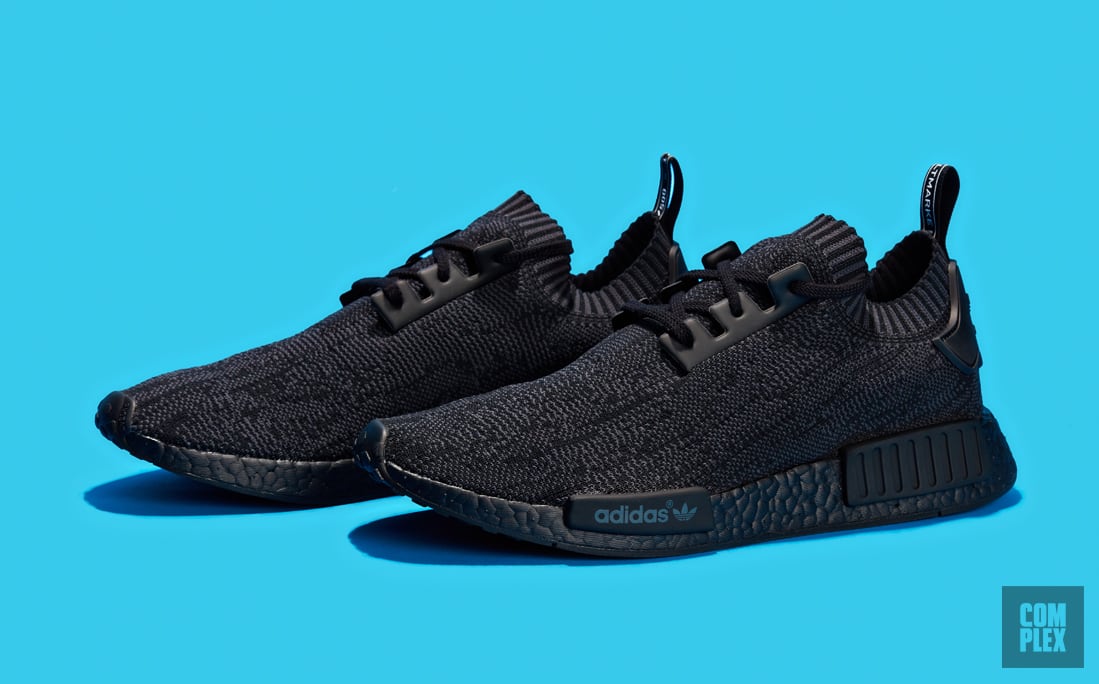
“It was a part of the Rimowa travel kit collaborative project called ‘Urban Utility Unit,’ which included standout items like our NMD Pitch Black sneakers, a Porter travel pouch, a SIGG water bottle, and a blacked-out Bluetooth Toothbrush,” Jagla says. According to him, the collaboration yielded one of the most engaging PR campaigns in Adidas history.
Of the 500 total sneakers made, only 100 were reserved for the general public via a Snapchat giveaway. The special pair commanded high price tags on secondary markets like eBay for upwards of $5,000.
The NMD Human Race (Hu), in partnership with Pharrell, also launched in 2016 and debuted the first sneaker in yellow with the words “Human Race” embroidered across the upper. The sneaker sold out instantly and is still one of the most valuable NMDs created, at around $1,500.
By the end of the year, additional colors (black, blue, green, red, and tangerine) had been added to the collection, embroidered with unique messages that rifted off the “Human Race” motif—all helping to cement the significance of Hu.
“As with most projects Pharrell is involved in, his focus is on substance more than hype. Together, he and Adidas laid out a long-term plan for the shoe that would lead to more accessibility, and a vast array of colors all featuring messages of hope and community,” Davis explains.
In 2017, Adidas Originals released nearly 200 more models and, despite increased saturation, became the second-largest footwear brand in North America—overtaking Jordan Brand in the process.
With yet another strong year under its belt, Adidas continued releasing even more colorways and increasing supply numbers globally.
“The NMD was on fire, so the business pressure and expectations were increasing significantly,” Jagla says. “During that time, Adidas Originals created way too many models and as a result of the new business expectations, the product team had to create hundreds of colorways to make all accounts happy.”
Success from years prior and an increase in Adidas’ business goals resulted in too much of a focus on the NMD sneaker and not enough on creating newer products, partnerships, and technology.
Jagla says Adidas relied on the NMD and Ultra Boost as the “answer to every problem.” According to the former employee, almost every colorway sold out within seconds and had high sell-through rates at the brand’s commercial accounts. He also notes that the shoes had a trickle-down effect on other Adidas models like the Stan Smith and Superstar.
Although consumer demand was undeniable at the time, this level of reliance on a single product would eventually become unsustainable due to changing cultural tastes and stronger competition from the likes of Nike.
Midway into 2017 through 2018, Nike’s strategy shifted to fostering collaborations with more culturally relevant partners. This eventually helped the brand regain secondary market momentum, with two of the biggest partnerships being Virgil Abloh’s “The Ten” and Travis Scott’s collaborations with Nike and Jordan Brand.
The revitalized partnership strategy from Nike coupled with the market oversaturation of NMDs caused the momentum Adidas had generated to quickly fade by 2018—resulting in the hype cycle turning back to Nike.
Today, most NMDs found on the resale market go for less than retail value, but brand partner Pharrell Williams has helped keep the franchise somewhat relevant in conversations around hyped sneakers.
Pharrell’s successful HU line made him the perfect collaborator to debut the Adidas NMD S1 in June of 2021, via a now-deleted Instagram post. The post had no launch or sneaker information but helped generate conversations about what was to come for Adidas. The shoe eventually launched to the public on Sept. 22 for $180 and sold out immediately (it now goes for upwards of $500 on StockX).
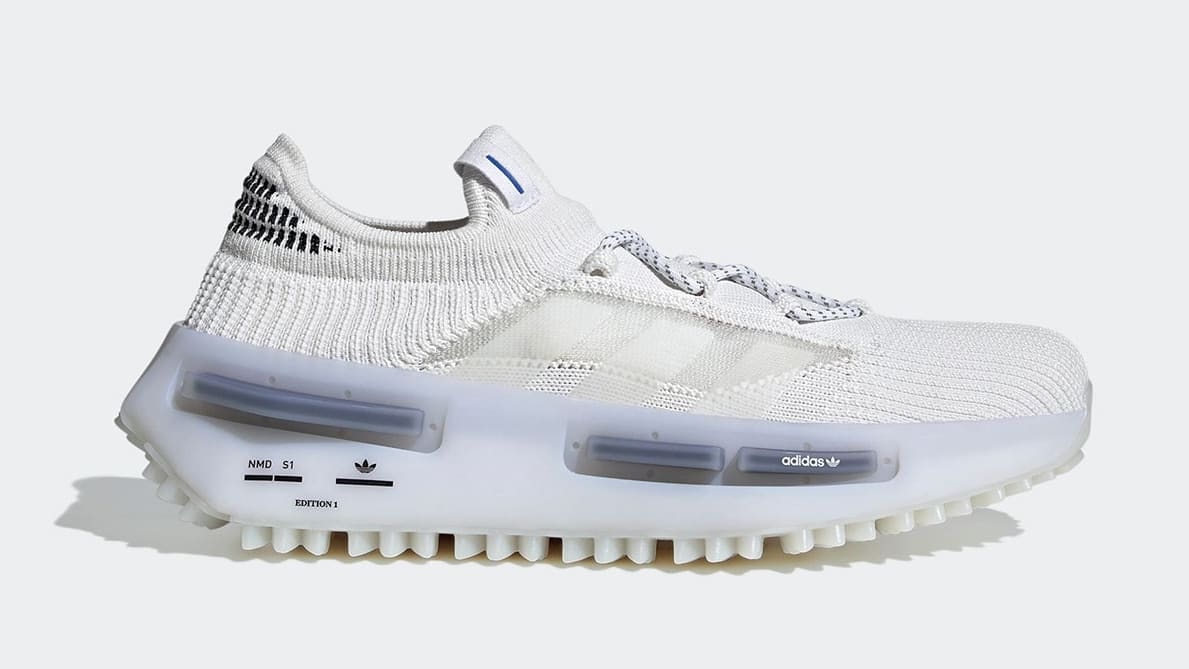
The NMD S1 (short for “Sneaker 1”), which nods to the success of the R1 and the new path the brand has embarked on, features an angled heel that pays homage to the Marathon TR for a more rugged, trail running aesthetic.
According to Oddbjorn Stavseng, the VP of footwear design for Adidas Originals, the direction behind the S1 came after a major realization. The “past empowers the future,” mantra that led to the original design for the NMD R1 no longer fit in a world where the demands of the “future” had so drastically changed compared to that of 2015.
The key then became connecting deeper with the original inception of the brand and allowing that design language to speak for itself.
Stavseng believes, “At the heart of the S1 is a desire to draw from the iconic simplicity of our past, and show what that looks like today. Adi Dassler [founder of Adidas] made shoes with no decoration—they were driven by purpose and every part of each silhouette was there for a reason. This notion of iconic simplicity is in the brand’s DNA, and we wanted to capture that mindset in S1.”
Davis does note that the new silhouette has not jumped out of the gates as strongly as the initial NMD R1 did via aftermarket presence. “Ultimately it is a reiteration of the same material and technology that have long been a part of the NMD framework and hasn’t driven new energy to the line of NMD products,” he says. As a result, the popularity of the S1 compared with that of the NMD R1, has not been nearly as high.
The NMD resonated with consumers during its reign because it stood for innovation, disruption, and comfort at a time when they needed it, but eventually stopped pushing boundaries and settled on the product as the end-all-be-all for success.
While it looks unlikely that the NMD will ever return to its former glory, only time will truly tell. But for Jagla there is still hope, “In general, I believe that a product so successful can always garner a strong comeback,” he says.

